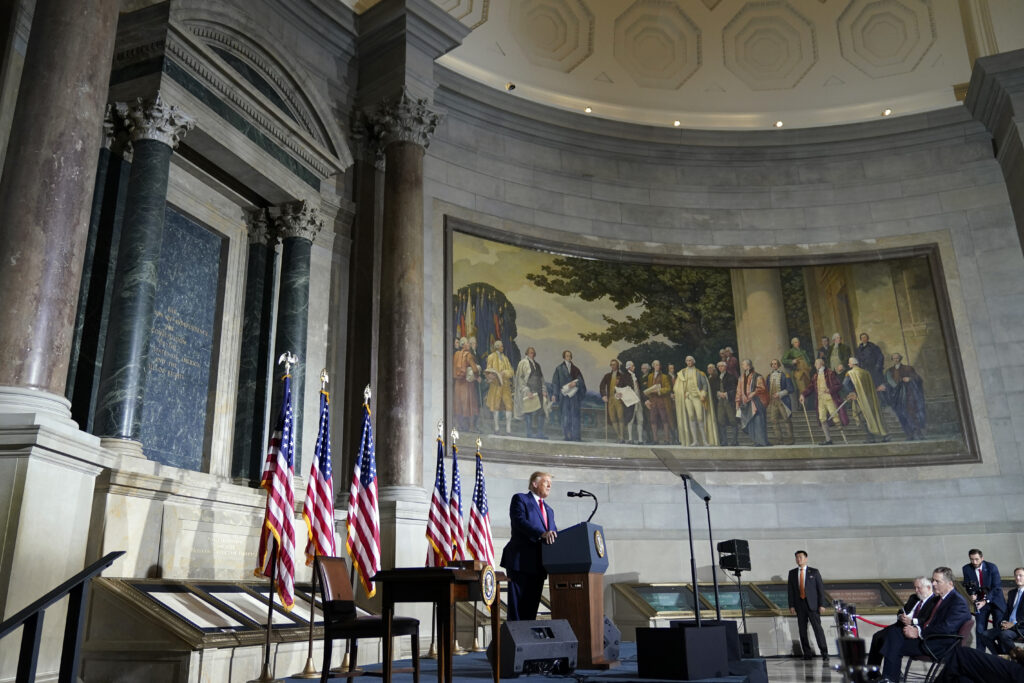Introduction
Welcome to The Moment. I’m Susan Smith Richardson, CEO of the Center for Public Integrity.
Earlier this month, President Donald Trump ordered the Office of Management and Budget to stop federal agencies from any government training programs that included references to critical race theory or white privilege, calling them divisive and anti-American.
Ian Haney López, the Chief Justice Earl Warren Professor of Public Law at the University of California, Berkeley, specializes in critical race theory and is the author of “Merge Left: Fusing Race and Class, Winning Elections, and Saving America.” Trump’s mischaracterization of critical race theory as an attack on white people is part of his ongoing efforts to weaponize race to pit whites against people of color, says Haney López.
My interview with Haney López was on Sept. 17, Constitution Day, and Trump was at the National Archives promoting his ideas to “restore patriotic education” to schools and denouncing The 1619 Project, the New York Times Magazine series on the legacy of slavery, and critical race theory as “toxic propaganda.”
And now a moment with Ian Haney López…
*This interview was edited and condensed for clarity.
What is critical race theory?
I think you can only really understand critical race theory by understanding what it was reacting to. There was, and remains to a certain extent, something that can be called liberal race theory. And liberal race theory understands racism in a fairly truncated way. It understands racism as personal prejudice that risks nothing more than errors in judgment — the sort of personal prejudice that liberal race theorists deemed could be cured simply by getting to know people across racial divisions. To see that in operation, you can think about the grand hopes in the 1950s for school integration. There was a sense that school integration and justice required little more than Black and white children mixing in schools, and they would get to know each other, and voilà, no more racism.
Critical race theory responds to that by saying individual prejudice, yes, that’s real. That’s a major thing. But we have to understand that racism has been essential to the foundation of this country and indeed essential to the creation of the modern world. Capitalism and racism co-evolved under colonialism, including in what would become the United States of America. … Now, once you move to this notion that racism is actually a part of the way that the country was founded, you then have to have a lot of very challenging conversations about how racism is part of our culture. It’s built into our institutions.
Two important points that I really want to emphasize: One, the critical in critical race theory is a gesture toward European philosophical thinking that said almost all of our practices and ideas are socially produced. They do not exist in nature. They are not handed down from God. They are socially produced. … The other important insight is that racism is a complex phenomenon that requires serious study. And you can’t hope to understand racism simply on the basis of living race in your daily life, just as you cannot hope to understand the economy because you are spending money every day to buy goods. That doesn’t make you an economist. It doesn’t make you an expert on the economy. Likewise, living in a racially stratified society doesn’t mean you understand race and racism.
Give me an example of a law that reflects what you just said.
So, my first book was entitled “White by Law,” and it examined one of the first laws that Congress enacted. Under the Constitution, the first Constitution, the Constitution of 1787, it wasn’t clear who would be a citizen and who could [be a citizen]. In 1790, Congress passed a law that said only free white persons could naturalize and become a U.S. citizen. But, in turn, this required courts to interpret who was white. And more than that, because courts need to reason in a way that allows their judgments to be transparent and could be extended to other cases, they not only had to rule on individual cases, white or not, they had to explain their reasoning.
The result is an astounding series of cases, including two decided in the U.S. Supreme Court, that seek to define who is white and why some people are white, and others are not. In other words, what we see is the courts directly engaged in the legal and social production of racial categories. To emphasize again, there is no white race as a matter of biology, as a matter of nature.

What do you think is the purpose of President Trump’s attack on critical race theory? Why now?
In order to understand what President Trump is doing, you have to understand his basic strategy for getting elected in 2016 and for possible reelection in 2020. His basic strategy is to promote a story in which a country is locked into a racial battle between whites and non-whites. And he wants to encourage people to believe that battle is really inevitable and that they have no choice but to choose sides. One way that battle is framed is as direct physical threats to whites. And that’s the rhetoric of law and order: arson, looting, terrorism.
But another part of his story is the threat of cultural replacement. And this is evidenced in his rhetoric about, for example, cancel culture or even the rhetoric “Make America Great Again.” Part of the story he’s telling is, hey, this country is fundamentally a white country, was built by whites. It’s led by whites. It evinces the values of whites. And yet white culture is right now under threat of being replaced and disrespected and that there’s this new culture that’s arising that in fact denigrates and insults whites and celebrates people of color. That’s the story in which these attacks on The 1619 Project and critical race theory fit. … That’s why in the president’s version, critical race theory is said to claim that whites are inherently evil, that there is this fixed condemnation of white people that is supposedly emanating from critical race theory and progressive scholars.
But, of course, that’s an outrageous lie. Rather, what critical race theory is saying is we need to take racism seriously. We’re all enmeshed in this system, and all of us have a capacity to change. All of us have the capacity to see our shared humanity, to connect and build bridges across racial differences, and to build a multiracial society in which every family is valued and has a place, whether they are people of color or white.
We can’t do this work without your support.
Ian’s must-read list:
Raceclassacademy.com is a platform he co-founded that “explains our political descent as well as the way forward by showing how racial division has served as the main weapon in the class war the rich have been winning.”
“Whiteness as Property” by Cheryl I. Harris explores how white racial identity became the basis for privilege and receiving public and private benefits in American society. The ground-breaking analysis was published in the “Harvard Law Review” in 1993.
Thanks for reading The Moment. What questions do you want to explore? Send them to me at ssmithrichardson@publicintegrity.org. Until next time.




Join the conversation
Show Comments